Dalton Highway
The James W. Dalton Highway (Alaska Route 11, the "Dalton Highway", "the Dalton", or the "Haul Road") is a 414 mi (666 km) road traversing central and northern Alaska. It is one of only two roads in North America (the other being the Dempster Highway in Yukon, Canada) that cross the Arctic Circle and connect to the rest of the North American road network. It begins at Mile 73 of the Elliott Highway (Alaska Route 2) 84 mi (135 km) north of Fairbanks and ends at Deadhorse near the Arctic Ocean amid the Prudhoe Bay oilfield.
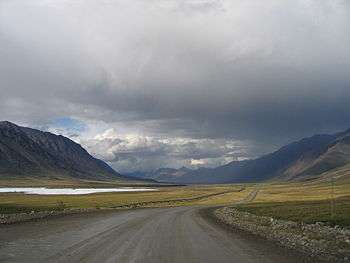
- This article is an itinerary.
The scenic Dalton Highway passes courses through boreal forests, across the Yukon river and the Arctic Circle, through the Brooks Range mountains, the Continental Divide at Atigun pass, and finally traverses the treeless North Slope tundra to the Deadhorse and the Prudhoe Bay oilfields near the Arctic Ocean. While travel up the entirety of this road is quite an undertaking, the journey rewards drivers with breathtaking vistas and the experience of America's Arctic, its wildlife and landscape.
Understand
History
When oil was discovered at Prudhoe Bay in 1969, the state of Alaska operated as a "boom-and-bust economy" without any stable industries and, more importantly, America was critically short of oil and mostly at the mercy of volatile Arab nations (just two years after the Arab-Israeli Six-Day War). Plans for drilling the oil and for an 800 mi pipeline were thrown together at a dizzying speed, as the U.S. government and oil companies worked to settle land claims with Native Americans, attain proper permits, ensure environmental safeguards, and build ways of accessing this extremely remote area. The Dalton Highway was hastily constructed in just 5 months, in 1974, to provide access for the Trans-Alaska Pipeline under construction. It was built at a similar, dizzying pace, price, and fashion as the nearby Alaska Highway, constructed during World War Two.
Built as the North Slope Haul Road (or simply the "Haul Road", as some locals still call it), it was a supply road and intended for large tractor-trailers rather than private vehicles. After completion of the pipeline, the road remained as a supply route for oil operations at Prudhoe Bay. In 1981 the haul road was opened to the public (with a permit) until Disaster Creek at Mile 211, given the designation Alaska Route 11, and named in honor of James W. Dalton, a man who aided in the development of the Cold War's Distant Early Warning System and whose knowledge of northern Alaska greatly aided the oil exploration of the region. In 1994, the public was allowed access to the entire highway to Mile 414 in Deadhorse, without permits. The road used to be gravel for its entire length, but it is now paved from Mile 37 to Mile 49; Mile 90 to Mile 197 (Gold Creek); and from Mile 335 (Happy Valley airstrip) to Mile 362. Due to the extreme temperature variations and frost heave, paved sections are prone to potholes and large cracks and some paved sections are worse than unpaved sections.
Climate
|
Now That's Cold! The coldest temperature ever recorded in the United States was measured in Prospect Creek, Alaska. Prospect Creek was a temporary camp for construction workers for the Trans-Alaska Pipeline that is a few miles east of the Dalton Highway at Mile 134. It is no longer inhabited. On 23 Jan 1971 a low of -82°F (-62°C) was recorded. The only temperature ever recorded in North America lower than this was by just one degree...-83°F (-63°C) in Snag, Yukon, Canada on 3 Feb 1947. |
The climate of the regions this highway traverses range from subarctic to polar. During the summer months (Jun-Aug), the average maximum temperatures range from 70°F (21°C) to 50°F (10°C) with average minimum temperatures ranging from 50°F (10°C) to 35°F (2°C). Travel on the highway during the months of May and September is a bit colder, although travel along the highway is not considerably more dangerous during these months. Average maximums during these two months are approximately 35-60°F (2-16°C) and average minimums 40-15°F (4 to -9°C). The temperatures given are average, be prepared for temperatures as much as 20°F (11°C) outside of said ranges. While the highway is open all year (more trucks traverse it in winter than summer!), travel from late September through early May is frigid and lethally cold through the heart of winter. Temperatures below -40°F (-40°C) are very common and temperatures as low as -60°F (-57°C) are certainly possible—before factoring in windchill. The record low windchill in Deadhorse was -102°F (-74°C) on 28 Feb 1989! A chart record of windchill at ARCO's facility in Prudhoe Bay on 13 Jan 1975 shows -128°F (-89°C). Such temperatures are lethal in less than one minute if you are not prepared for them. Unless you are experienced with polar temperatures, including its effects on vehicles and gear, do not attempt to traverse the highway between November and March!
North of the Arctic Circle (Mile 115), there are 24 hours of daylight in the summer and 24 hours of darkness in the winter. In Deadhorse for instance, the longest "day" is 63 days, 23 hours, 40 minutes (12:09AM on 20 May to 11:18PM 22 Jul); likewise, the longest "night" in Deadhorse is 54 days, 22 hours, 51 min (12:27PM 24 Nov to 11:18AM 18 Jan).
Talk
English is spoken by all persons living and working along the highway, including residents of the Native Alaskan villages accessible from the Dalton via the Yukon River. As the road is primarily a trucking highway, and there is virtually no cell phone coverage along the highway, the "official" method of communication along the highway is over CB radio, Channel 19. Channel 19 is listened to by truckers, fellow travelers, pipeline security, Alaska State Troopers (police), and others. Not only can you talk in the event of an emergency, but you can also listen to others' conversation which may alert you to hazards and current conditions on the road ahead. CB radios can be rented or purchased from numerous equipment outfitters around Fairbanks. There are just a few places along the highway which offer a place to rest and encounter other persons, namely the handful of towns along the road.
Deadhorse is the only location on the highway with cell phone reception. Satellite phones, while extremely expensive, are handy and commonly used by workers in the area for ranges longer than other radios. However, not all satellite phone networks have coverage in this region. The entire Dalton is covered by Iridium and Globalstar (including SPOT messenger service). Fairbanks appears to be the edge of Inmarsat coverage, with the Dalton lying outside of Inmarsat coverage. Thuraya does not provide service in the Americas.
Get in

By plane
The nearest major airport to the highway is in Fairbanks (FAI IATA). Aside from numerous Alaska Airlines and turboprop flights to destinations within Alaska, Fairbanks International Airport has commercial service available to: Seattle/Tacoma Airport (Alaska Airlines; seasonal, Delta Air Lines), Portland (seasonal, Alaska Airlines), Minneapolis/St. Paul (seasonal, Delta Air Lines), Denver (seasonal, Frontier Airlines & United Airlines), Chicago-O'Hare (seasonal, United Airlines), and Frankfurt Airport, Germany (seasonal, Condor Airlines). Deadhorse does have an airport handling limited commercial flights (Alaskan Airlines to Barrow, Fairbanks, & Anchorage), but all organized tours originate from Fairbanks, and there are no car rentals available here. As flying into Deadhorse is more expensive and has limited options for getting onto the highway (you could try to hitch a ride with a truck driver, but don't expect any stops), the only practical means of arrival by air is Fairbanks or Anchorage if you want to rent a car there to explore southern Alaska as well (see Anchorage article for flights there).
By car
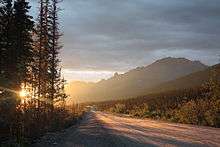
From Fairbanks, you can rent a vehicle (4x4 truck recommended) and drive to the Dalton Highway. However, the major car rental companies explicitly prohibit the travel of their vehicles on a long list of Alaskan roads, including the Dalton Highway.
It is strongly recommended that you travel with a full-sized spare tire; the road is rough enough that a small spare will be of little use and towing costs can be as high as $5/mile.
The following companies, in alphabetical order, rent vehicles for use on the Dalton and other rugged Alaskan highways:
- Alaska Travel Center, Go North, &PARA tours, 3500 Davis Rd, Fairbanks, ☎ +1 907-479-PARA (7272). Click "travel services" then "RV and car rental". They offer full-size pickup trucks, SUVs, small RVs, and truck campers.
- Arctic Outfitters, ☎ +1 907-474-3530, fax: +1 907-474-4767, e-mail: adventure@northernalaska.com. Rents fully outfitted Ford Escapes. Rentals include: CB radio, 2 full-size spare tires, first aid kit, tire changing kit, satellite phone. A bit pricey, but great customer service.
If you are driving your personal vehicle it is important to remember that the purpose of this highway is for trucks and that the road is designed for them rather than for personal vehicles (see "get around"). Roundtrip, you will be traveling 828 mi (1333 km) on a mostly gravel road while being passed on numerous occasions by speeding semi-trucks hurling gravel at your vehicle. Many company and semi-drivers are courteous and will slow from the oncoming direction; however, some do not and gravel will hit your windshield. If being passed from behind, it is often best to find a safe place to pull off and let the other driver by. This will let them pass at a safe speed and reduce the risk of road debris being kicked up onto your vehicle (it's also just good manners). Additionally, there are many potholes on the road (more so on paved parts), some big enough to swallow basketballs. Such dangers can wreak havoc on a small car's suspension and you might be left with a few scratches and dents on your car (i.e., don't take your new Mercedes down this road). A vehicle such as an SUV or pickup truck is preferred due to their ruggedness and ability to cope with road conditions. One Fairbanks car rental agency used to claim that large sedans were better due to their lower center of gravity, but since sedans were what they rented (for a rental cost similar to larger, newer, & more expensive trucks & SUVs), that may not have been entirely truthful. And in the end, due to considerable damage caused by the low clearance and inexperienced driving, this company no longer rents sedans.
Refer to the Fairbanks article regarding reaching Fairbanks by car. The southern terminus of the Dalton Highway can be reached by car from Fairbanks via the Steese Highway then, at Fox (11 mi [18 km] north of Fairbanks), the Elliot Highway; both road segments are numbered as Alaska Route 2. The Dalton Highway begins at Livengood (no services), Mile 73 of the Elliot Highway. Follow the signs to the Dalton Highway. It is about an hour and a half drive from Fairbanks to Livengood. There are no gas stations between Fairbanks and the start of the Dalton. Once on the Dalton Highway, there is gas available at the Yukon River and at Coldfoot ($5.39 per gallon in summer 2011). After that, there are no services of any kind for 240 miles (386 km) at Deadhorse. Do not take this information lightly.
By tour bus
There are several companies in the Fairbanks area which take tourists on the Dalton Highway in vans or buses. While the price for such a tour could be more expensive for a family than renting your own car to take on the highway, for individuals and couples the cost of a tour may outweigh the costs and hassles of renting a vehicle. The biggest advantage of taking a tour bus is the lack of concern for breaking down, battling trucks speeding by, and concern for things like gas and food. However, the tour bus limits one's flexibility while on the trip and most tour buses take two days going to Deadhorse and one back. Tour buses stop at the hotels at night and you won't be able to save money by camping.
- Northern Alaska Tour Company, ☎ +1 907-474-8600. Provides round-trip bus trips to Arctic Circle only ($189). Bus to Coldfoot returning on turboprop plane. Fairbanks to Deadhorse flying one way and returning by ground in the other, overnight at Coldfoot ($989). And more...see website
- Dalton Highway Express, ☎ +1 907-475-3555. Think of this as a bus service rather than tour. DHE makes quick stops, no stops for photos. Reservations must be made at least 14 days in advance. $116-428 round-trip.
- Trans Arctic Circle Treks, ☎ +1 907-479-5451, e-mail: arctictreks@alaska.com.
Prepare
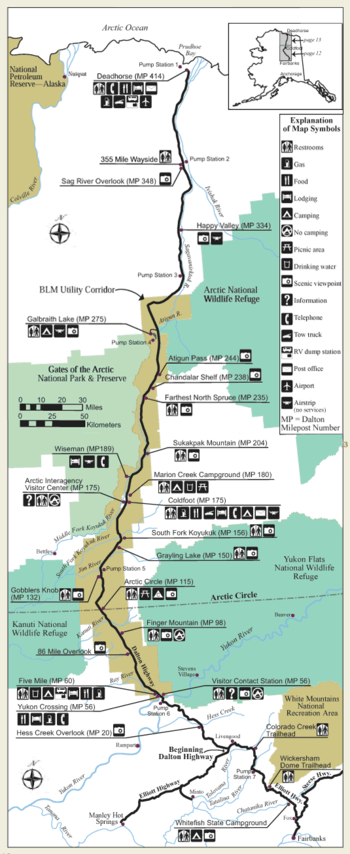
See also: Winter driving.
The Dalton Highway has the distinction of (among other things) having the longest stretch of serviceless road in North America. North of Coldfoot, there is a 240 mi (386 km) stretch of road with no gas stations, restaurants, hotels, or any other basic services until the Prudhoe Bay oilfield at Deadhorse. Therefore, travelers are advised to have basic survival supplies, car repair equipment, and equipment for camping and other activities, stocking up no further north than Fairbanks, as all four communities further north offering services are extremely expensive, and since Fairbanks is a small city (pop. 32,000), there will be bargains to be found. Drivers should check and replace worn belts & hoses on their vehicles and ensure all tires (including spares) are properly inflated.
- CB radio or Satellite phone (though expensive) since cellular service is extremely limited. CB radios are far less expensive.
- Cash and/or major credit cards (i.e. Visa or MasterCard). No services accept debit cards and there is only one ATM in Deadhorse.
- Spare tires (full-size, preferably on/with another rim and chains for all four tires) and basic car repair tools.
- Kits used to repair windshield chipping can be especially valuable in preventing chips from turning into full-fledged cracked windshields (especially valuable for rentals, where damage can be very costly).
- Spare windshield wipers, as well as several gallons of windshield cleaning fluid (you will need to clean your windshield many times from the dust trucks create, and mosquito/insect build-up from approximately late May to early September). At times, wipers won't clean thoroughly, so have paper towels on hand to "hand wash" the windshield.
- Road flares (trucks can't stop quickly and there are numerous blind corners/crests)
- Protection against the elements (warm clothes, rain jackets, blankets, etc.)
- Spare fuel (at minimum a 5- or 10-gallon container (19-38 l)), ideally purchased in Fairbanks to offset the high prices northward. Keep in mind that vapor can vent from containers of gasoline, posing a danger if stored inside of a vehicle (including an enclosed trunk).
- Food, including healthy snacks and ready-to-eat meals.
- Several gallons of bottled water.
- Garbage/rubbish bags
- Toilet paper, hand sanitizer, soap and water.
- First Aid kit
- Insect repellent ("Off!" and the like, and/or the "Skin So Soft" variety) and/or mosquito netting.
- Optional: Camping equipment, stove/pots (to cook food and/or boil stream water or snow, and/or high-quality water "Brita" pitchers with several additional filters), satellite phone (though expensive) since cellular service is extremely limited, canoes, kayaks, rafts, handgun or rifle and several bullets (for hunting or bear protection), and for hiking: a backpack, hiking pole, bear repellent spray, knee-high waterproof boots (for marshes); parka, maximum head and face protection & snow shoes (winter).
If you plan on adventuring, there are several equipment rental stores in/around Fairbanks, including:
- Alaska Outdoor Rentals & Guides, ☎ +1 907-457-2453, e-mail: larry@2paddle1.com. 11:30AM-5:30PM.
- GoNorth Alaska Travel Center, 3500 Davis Rd, Fairbanks, ☎ +1 907-479-7272, e-mail: para@alaska.net. Started as a business offering river trips and hiking trips in the Brooks Range.
Gas stations
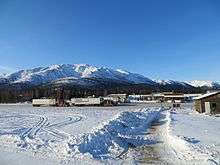
For the person traveling the Dalton, gas is infrequent and expensive. While you may be following a pipeline that transports over 700,000 barrels of oil per day (a large percentage of America's oil supply), that oil has to travel south to California to be refined, then sent back up to Alaska and transported hundreds of miles by not-so-fuel-efficient trucks to these gas stations... so as oil-rich as the area may be, expect to pay the highest prices in the United States ($1–2 more per gallon than the national average). Combine this with the long distances, and one thing is clear: you'll need gas and it's not cheap. The last gas station leaving the Fairbanks area is Hilltop Truck Stop in Fox, where the Elliot Highway splits from the Steese Highway. Afterward, there are just three locations to fuel along the Dalton.
- Yukon River crossing (Mile 56). Closed in winter.
- Coldfoot, gasoline is available from Sourdough Fuel (Mile 175).
- Deadhorse, gasoline is available from three stations. (Mile 441).
That's all... three locations with gas stations along the entire highway!
Driving
See also: Tips for road trips and Winter driving.
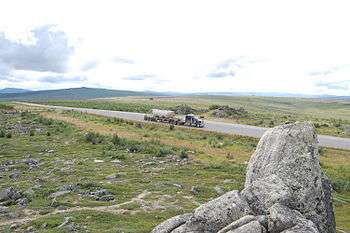
The speed limit on the Dalton Highway is 50 mph (80 km/h) its entire length and keep your headlights on at all times! Use parking lights if parked near the road (although you should park far off the road) and emergency blinkers if disabled. Raising the hood of your vehicle can signal to passing drivers that you are disabled and may elicit help from passing drivers. If making repairs on a vehicle, park at least 10 ft (3.5 m) off the road to avoid being hit or pelted with gravel.
The road was built for trucks carrying supplies to the oilfield. Trucks have the right of way! Understand that what may be a simple task in a car can be much more different in a large truck. Trucks cannot brake as quickly, nor can they "get out of the way" as easily. Many trucks have overturned as a result of hitting the berm or ditch at high speed, whereas a car can (much more) easily and safely get out of the way.
Always slow down when passing an oncoming vehicle; it is common courtesy as a stone flung at your windshield at 50 mph will do a lot more damage than one flung at 10 mph. Check your rearview mirror frequently and pull over to allow vehicles to pass you. If you want to pass a vehicle ahead of you, flash your bright lights, turn your lights on/off, or tap the horn lightly; tap the horn as you're passing in appreciation. Finally, if you're stranded, don't expect trucks to stop for you. It wastes a considerable amount of fuel to come to a stop, idle while helping you, and then get back up to cruising speed.
There are many steep grades on the Dalton, especially in the Brooks Range (many at the maximum 12%). In wintery weather, chains may be required to gain traction ascending these slopes. Be sure to carry chains with you, even in months like June or September.
Check current conditions
It is very important to check the road conditions and weather warnings and forecasts before leaving, especially outside of July and August. While driving expect that at any given time a section of the road may be shut down due to storm or other damage, causing anywhere from a few hours to several days delay. There is one DOT webcam along the route, on the north side of the Brooks Range .
Road conditions
- Road conditions and any special warnings, . Select the "All Reports" bubble at top and "Northern Alaska" from the maps pulldown menu.
- Visitor centers at the Yukon River and Coldfoot. Summer only, in person or call +2 907-678-5209 (Coldfoot).
- Alaska Department of Transportation (Fairbanks). Road conditions all year. +1 907-456-5209.
- Alaska Public Lands Information Center. All year. +1 907-456-0527.
Weather
- National Weather Service current weather advisories. Draw a straight line from Fairbanks to the region to the right of Barrow and the 4 regions you pass through are the ones the Dalton does.
- National Weather Service current weather conditions. Relative cities include: Deadhorse, Bettles (near Coldfoot),& Manley Hot Springs (closer to start than Fairbanks). Do not rely on Fairbanks, as it lies in a valley making it warmer in summer and colder in winter than most of the Dalton Highway.
- National Weather Service forecasts: North Slope (relative sections are "Central Beaufort Sea coast" for Deadhorse, "Northeastern Brooks Range" for Atigun Pass) and Interior Alaska (relative sections are "Southeastern Brooks Range" for Coldfoot and "Central Interior" for Livengood).
Itinerary
The Dalton Highway begins at Mile 73 of the Elliot Highway, 84 miles (134 km) north of Fairbanks, in the area known as "Livengood". The following points of interest along the highway are listed by mile from the start.
Boreal Forests (Miles 0-175)
Miles 0-175 are dominated by boreal forests. Much of this stretch of the highway was ravaged by wildfires in 2004 & 2005 (Alaska's 1st & 3rd largest fire seasons of record), leaving behind many swaths of charred trees. Most, but not all, of the wildlife in this region has left. With only skinny trees obscuring your view, the fireweed flowers (so named for their tendency to colonize fire ravaged regions) give the forest floors a carpet of bright pink, wildflowers peak in early July.
- Mile 24 A pullout beside the Hess Creek, providing a safe place to park and take a break.
- Mile 54 Pump station #6. This station is one of the eleven pump stations that keep oil flowing through the 800 mile pipeline. While the stations are numbered from one to twelve, station eleven was never built.
- Mile 56 Yukon River Here, the Dalton Highway and pipeline pass over the mighty and wild Yukon River, which runs nearly 2,000 miles (3,220 km) from Canada to the Bering Sea. There is a Bureau of Land Services visitor's center (no phone), which provides information about the status of the highway, information regarding federal lands along the highway (such as Gates of the Arctic National Wildlife Refuge), and helps tourists with planning their trip along the Dalton and what lies ahead. There is a small hotel, a Northern Ventures gasoline station (closed in winter), tire/mechanic shop, and Yukon River Ventures(provides riverboat tours along the Yukon). Be sure to get unique photos of the pipeline suspended over the river (in lieu of a bridge).
- Mile 60 A campsite with outhouse, potable water, trash bins, and gas are available just down the road at mile 60. There is also a former construction-camp-turned-hotel () for $199/night. Nearby is a restaurant, open mid-May to mid-September, serving possibly the best food on the highway (), but pricey: day-long breakfast $8–14, lunch $10–12, dinner $16–26. The hotel/restaurant/gift shop may be closed. Its website remains up as of 2014, but was last updated 2011, and the 2014 Dalton Highway visitor's guide only mentions a campsite at Mile 60.
- Mile 73 First of a series of steep hills—the "Roller Coaster"—in a 60 mi (100 km) segment of the Dalton. The hill at Mile 73 is known as "Sand Hill".
- Mile 75 "Roller Coaster Hill".
- Mile 86.5 There is a minor road off the west side of the highway which leads up a hill to a gravel pit (beware heavy equipment), affording great views of the Yukon Flats National Wildlife Refuge.
- Mile 87 "Mackey Hill"
- Mile 98 A pullout on "Finger Mountain" which has a half-mile trail with several information signs. Great photo opportunity.
- Mile 110 "Beaver Slide" hill.
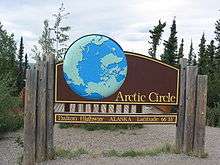
- Mile 115: Arctic Circle A pullout with picnic area, information boards a large sign denoting the Arctic Circle, the southernmost latitude where the sun remains above the horizon for 24 hours on the summer solstice (21 Jun) and below the horizon on the winter solstice (21 Dec). There are camping sites up the hill and behind the picnic area with an outhouse and trash bins. Camping is not permitted in the picnic area nor viewing deck.
- Mile 132 A pullout with incredible views of the Brooks Range to the north. "Gobblers Knob" hill.
- Mile 137 Pump station #5. Unlike other stations pump station #5 is actually a pressure relief station that slows down oil that is speeding down the pipeline after the descent from the Brooks Range.
- Mile 150 Grayling Lake A picturesque lake carved thousands of years ago by glaciers. Popular with moose in summer looking for a drink.
- Mile 175: Coldfoot (Pop.13) Founded in 1898, abandoned in 1912, and revived as a construction camp in 1970, Coldfoot is a major stop on the highway. There is a restaurant, tire shop, post office, gift shop, hook-ups for RVs, campsites, and an inn. Additionally there is a "visitor's center" in Coldfoot offering information on recreation & visitor services along the Dalton. After Coldfoot, there are 240 miles (386 km) without services such as gas or food... the longest such stretch in the United States! Leave prepared. Do not take this warning lightly!
Brooks Range (Miles 175-275)
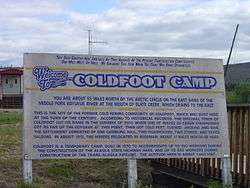
Miles 175-275 run through the Brooks Range mountains. The landscape is composed of tall, jagged mountains, valleys, and gorges. This is prime location on the Dalton for hiking. Compared to the North Slope and Coastal Plain, which receive less than 10 inches of precipitation a year, the Brooks Range is frequented by blizzards, windy, and prone to snow even in July!
- Mile 180 The only developed campsite along the highway with 27 campsites (for a fee, Memorial Day to Labor Day), potable water, an outhouse, trash bins, fire pits. Hiking 2 mi upstream leads to a 20-ft waterfall.
- Mile 188: Wiseman (Pop. 22), located 3 mi off the Dalton Highway, is a quaint little mining town founded in 1907 by persons who abandoned the Coldfoot settlement, finding gold in a nearby creek. This historic village, and its residents subsistent on hunting and gardening, makes for a great stop on your trip. Keep in mind that all buildings are private property.
- Mile 203 A great view of nearby Sukakpak mountain (4458 ft / 1338 m), with a massive face (i.e. cliff) facing you.
- Mile 235 The further north you go, the fewer trees there are (due to permafrost and extreme cold). Here lies the furthest north spruce tree on the highway. It was killed by a vandal in 2004, estimated to be 273 years old.
- Mile 237 Good viewpoint. The next few miles are a major avalanche hazard in the winter. The ADOT station here does not provide services; it stores cannons and road-clearing vehicles. They fire artillery shells in winter to clear the slopes above the highway.
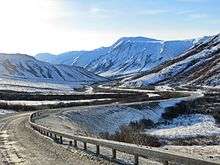
- Mile 244 Atigun Pass at 4739 ft (1422 m), is the highest point on the highway and marks the Continental Divide (water that falls to the south flows into the Pacific Ocean or Bering Sea, to the north the Arctic Ocean). The area is prone to snow, even in July, and is a prime location for seeing Dall sheep.
- Mile 269 Pump station #4. At 2760 feet this station has the highest elevation of any pumping station along the oil pipeline.
North Slope (Miles 275-355)
Miles 275-355 pass through the North Slope, which is entirely permafrost and home to many herds of caribou, groups of muskox, as well as predatory birds, such as falcons. The only plants in this region are tough, ground-hugging shrubs. As the name implies, this is a slope leading from the Brooks Range down to the low-lying Coastal Plain.
- Mile 275 Galbraith lake carved by a glacier along with the rest of the Atigun valley. A short hike downstream leads into the Arctic National Wildlife Refuge and to spectacular Atigun Gorge, the lake, and the Brooks Range. Lots of wildflowers in early summer. Follow the signs to the airstrip and continue driving 2.5 miles on an unimproved road to a campsite with an outhouse and trash bins.
- Miles 278-293 No camping is permitted (due to environmental concerns).
- Mile 284 Toolik Lake. The University of Alaska Fairbanks research station is not open to the public. Avoid disturbing their research sites scattered nearby.
- Mile 312 Pump station #3.
- Mile 334 Location of a large construction worker camp during the building of the pipeline and known as "Happy Valley," there is a campsite. The airstrip is used for gov't and university studies in the area, so avoid camping on it.
- Mile 348 A pullover with a short trail and interpretive signs. Peregrine falcons feed in nearby bluffs in summer. The Philip Smith Mountains can be seen in the distance.
Arctic Coastal Plain (Miles 355-414)
Miles 355-414 pass through the Coastal Plain. This low-lying region, in summer, is largely marsh and wet-lands during the summer. Don't be fooled though as permafrost lies just inches below the bottom of these shallow marshes. The plain is home to significant numbers of caribou and migratory birds feasting on the billions of insects which breed in these marshes. In winter, the plain is a flat, solid, windswept wasteland with only the distant Brooks Range as something discernible.
- Mile 355 a pullover with an outhouse and trash containers.
- Mile 359 Pump station #2.
- Mile 383 Colorful, iron-rich bluffs on the far bank of the river. Caribou are often found along the river.
- Mile 414 Deadhorse (pop. 25, Mile 414), the northern terminus of the highway and essentially a "company town", is in the midst of the Prudhoe Bay oilfield, and has a non-permanent population of 2,000-3,000 employees of the various oil operations. The Dalton Highway ends just a few miles inland of the Arctic Ocean and Only private, restricted roads extend to the ocean. Fortunately, there are tours which can be booked through the hotels which not only take you to the ocean and its gravel beach (where you can take a frigid dip, joining the "Polar Bear Club") but also include a tour of the oilfield and operations. The ocean is ice-free from late July to October. Remember when leaving that there are no services for 240 miles (386 km) until you reach Coldfoot!
Travel times

At a minimum, plan three days to make the trip between Fairbanks to Deadhorse and back. Assuming good road and weather conditions, expect the following travel times from Fairbanks:
- to Yukon River — 3 hours
- to Arctic Circle — 4.5 hours
- to Coldfoot — 6 hours
- to Atigun Pass — 8 hours
- to Deadhorse — 13+ hours
The above times do not factor in rests, wildlife viewing, or delays due to construction or bad weather.
Distances
| Miles (km) | Fairbanks | Livengood | Yukon River | Arctic Circle | Coldfoot | Atigun Pass | Galbraith Lake | Deadhorse |
|---|---|---|---|---|---|---|---|---|
| Fairbanks | - | 84 (134) | 140 (225) | 199 (320) | 259 (417) | 328 (528) | 359 (578) | 498 (802) |
| Livengood | 84 (134) | - | 56 (90) | 115 (185) | 175 (282) | 244 (390) | 275 (443) | 414 (666) |
| Yukon River | 140 (225) | 56 (90) | - | 59 (94) | 119 (190) | 188 (303) | 219 (353) | 358 (576) |
| Arctic Circle | 199 (320) | 115 (185) | 59 (94) | - | 60 (97) | 129 (208) | 160 (258) | 299 (481) |
| Coldfoot | 259 (417) | 175 (282) | 119 (190) | 60 (97) | - | 69 (111) | 100 (161) | 239 (385) |
| Atigun Pass | 328 (528) | 244 (390) | 188 (303) | 129 (208) | 69 (111) | - | 31 (50) | 170 (274) |
| Galbraith Lake | 359 (578) | 275 (443) | 219 (353) | 160 (258) | 100 (161) | 31 (50) | - | 139 (224) |
| Deadhorse | 498 (802) | 414 (666) | 358 (576) | 299 (481) | 239 (385) | 170 (274) | 139 (224) | - |
Do
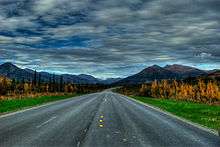
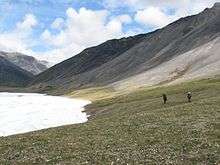
- Photography The Dalton Highway passes through incredibly beautiful terrain, and it would be a shame not to take pictures of it. Between the spectacular mountains, beautiful forests, wildlife, the Arctic Circle sign, Wiseman, the Yukon river, the North Slope, and the engineering marvel that is the Trans-Alaska Pipeline, there is no shortage of good photos. Do bring a telephoto lens to shoot wildlife at a distance.
- Camping This great wilderness is a great place to set up camp and enjoy the great outdoors (or maybe save $219/249 (as of 2019) that the Slate Creek Inn in Coldfoot wants to charge you).
- Just pull off the road at least 30 ft (10 m) and set up camp. See also: Car camping.
- If leaving the highway for an extended hike, a GPS device is helpful. Note, however, that declination can be 27-30+ degrees in this region.
- Hike/backpack Fresh air, free of smog and car fumes; short grass; no snakes or other hidden dangers; beautiful, unspoiled land. Why not? Walk through forests or tundra, climb one of the mountains of the Brooks Range. Once away from the highway, the virgin land appears before your eyes as it did to those in search of the Northwest Passage hundreds of years ago. Note that in recent years security along the pipeline has been increased, so heed all warning signs to avoid attracting attention from the helicopter patrols that frequently fly over the pipeline.
- Be careful to avoid bears.
- The best hiking is in the Brooks Range, where the Arctic National Wildlife Refuge lies to the east and the Gates of the Arctic National Park and Preserve to the west.
- If bringing a GPS, recommended for long hikes, the declination at this latitude is great. In the Brooks Range and North Slope, it can be as much as 27-30°+!
- The North Slope is largely marsh in the summer. It is filled with insects. Tall, waterproof boots are essential (remember that inches below the surface the ground is frozen...32°F/0°C) as is bug repellent.
- Hunting There are plenty of opportunities for hunting, but be sure you follow all laws. Both visitors' centers along the contact can advise you with hunting, and you are strongly recommended to contact them before hunting. The Alaskan moose is the largest moose species with males averaging 1400 lb, 7 ft tall, and carrying antlers 6 ft across. Men can talk down the friend who shot that measly 400 lb deer and women can get in touch with their "Sarah Palin side." Bow hunting is generally allowed everywhere. Furthermore, all hunting is prohibited within:
- 5 miles (8 km) of the highway/Pipeline (only applies to hunting with firearms), either side.
- the Gates of the Arctic National Park (but permitted in Gates of the Arctic National Preserve)
- Prudhoe Bay Closed Area
- As consequences are severe for unlawful hunting, be sure to have accurate maps of the boundaries and :stay out of prohibited areas'.
- Fishing is permissible in most streams and rivers. Visitor centers along the highway can provide a guide specifically about fishing along the Dalton. However, as fish reproduce and grow more slowly in these colder climates, you are encouraged to only catch-and-release fish. You will need an Alaska sport fishing license (nonresident 1–14 days, $20–80 as of 2008) which can likely be purchased in Fairbanks(call the Dept of Fish & Game in Fairbanks at +1 907-459-7207 for a list of vendors) or online, . Within 5 miles (8 km) of the highway, the following restrictions are in place:
- Fishing for salmon is prohibited
- Lake trout are catch-and-release only
- Daily bag/possession limit for Arctic greyling is 5.
|
There be gold in them there hills! In 2008, exploratory drilling for gold at Livengood, at the beginning of the highway, produced promising results. A deposit approximately 300 ft thick and 1 sq mi in size is believed to contain 5-10 million ounces of gold, worth around $4-10 billion at 2008/2009 prices! Mining won't begin for a couple of years, as the equipment will need to be connected to the nearest power lines... 60 miles away. |
- Gold Panning Many towns in this region began in the early 20th century as communities of gold miners and gold panning is permitted on any federal stream south of Atigun Pass (Mile 244), with the exception of the pipeline right-of-way (27 ft/8.2m). The visitor's centers can provide free brochures on mineral collection along the Dalton which even rates their potential for gold. The best places for gold panning have been near Coldfoot/Wiseman.
- Kayaking, Rafting, & Canoeing There are several possible river trips along the Dalton. The visitor center in Coldfoot is best for information on this matter. Canoes and rafts can be rented from several places in Fairbanks. Two rivers can provide an excellent trip along the Dalton, provided there is a driver to drive you vehicle from launch to pick-up:
- The Jim River and Middle Fork-Koyukuk River. Class I-II w/several access points along the highway.
- Antigun & Sagavanirktok Rivers. Class II-IV whitewater. Enter at Mile 271, exit at Mile 306.
- Ivishak National Wild RIver. Class II. Access by chartered air service from Deadhorse or Coldfoot.
- Cross country skiing is available in most months outside July. Bring your own skis, as there is nowhere to rent skis along the highway.
- Note that the region is extremely remote. You should bring appropriate maps (possibly available at the visitor's centers) or a GPS device when doing so. Remember declination can be as much as 27º-30º, so recalibrate your device before leaving the highway.
- Remember that when snow is present, temperatures are extremely cold. Plan for appropriate temperatures. Blizzards can occur in the Brooks Range even in every month but July!
- Riverboat on the Yukon River. At the Yukon River crossing, there is the Yukon River Tours shop which offers riverboat trips three times daily on the river, taking you down miles of the Yukon River and visiting a Native-American fish camp. As of 2006, $20 per person.
Stay safe
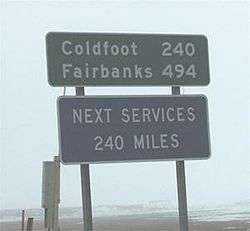
Remoteness
Due to the scarcity of services, the traveler on this road will need a certain degree of self-sufficiency while traveling along the highway on your own. Therefore, you are advised to bring what is listed in the Prepare section.
Road safety
A wide variety of different road surfaces will be encountered by travelers on the Dalton. The beginning 100 miles are said to be the worst (pothole wise), but that may just be the time it takes to get acclimated to road conditions. This surface is gravel/dirt and is littered with a landscape of craters and potholes that will often slow your pace down to the 10 mph mark, or destroy your suspension. Later on, a few patches of paved road will be encountered, but in a rough arctic environment like this, it is apparent they don't hold up too well. Be constantly on the lookout for massive potholes on any part of the road. These will sneak up on you suddenly after a comfortable few miles. Further north, the gravel roads seem to be in better condition and they permit higher speeds.
Health
There are no medical facilities on the highway. The nearest hospital is in Fairbanks. Oil companies likely have limited clinical facilities in Deadhorse should you find yourself in desperate circumstances, but are otherwise only for employees. Should you find yourself gravely ill, a medical evacuation is very expensive, takes much longer than is standard in the rest of the US, and can be limited or impossible during severe winter weather.
Should you decide to collect water from streams, it is advisable to boil such water as giardia is common in Alaskan streams and very contagious.
Weather hazards
Weather is an important factor to add into Dalton Highway Trip calculations. Remember, this is the Arctic! During the summer it is very possible to encounter heavy snow while driving through the Brooks Range via Atigun Pass. Drive with extreme caution on the windy mountain roads. The gravel can be very slippery, especially in rain or snow. During the winter, the area may sustain temperatures below -60°F (-51°C) (which is cold enough to freeze your brake fluid!). As mentioned earlier such temperatures are fatal and thus winter travel is highly discouraged.
Animal life
The Dalton Highway passes through territory of the fearsome grizzly bear. Understand that black bear attacks are almost always defensive, whereas grizzly bear attacks are predatory (often unexpected). Bear repellent spray (a very strong pepper spray/mace) is considerably safer than carrying a rifle. See this article for comprehensive information on bear safety. In the winter, Polar bears can roam the North Slope. Polar bears are massive, as ferocious as the grizzly bear, and very stealthy (and in darkness, not very discernible from the snow). Fortunately, you probably won't be outdoors during the season polar bears migrate into the region. You cannot learn enough about bear safety in this region. Consult one of the visitor's centers along the highway for more information and brochures.
You may encounter wolves and foxes in this region. Moose can be dangerous if threatened. They weigh, on average, 1,400 lb (640 kg) and have 6 ft wide antlers. Being mauled or stepped on by a moose can be lethal or leave you seriously injured in a region where medical services are distant and take hours for you to be treated. Animal life along the Dalton is great, but enjoy them at a distance.
Also visible are Dall sheep, muskox, caribou, wolverine (rare), and other smaller mammals.
Emergency services
- Fairbanks Medical Dispatch: (life-threatening emergencies only) +1-800-811-0911
- Alaska State Troopers (police):
- CB radio: Channel 19
- Coldfoot +1 907-678-5211
- Fairbanks +1 907-451-5100
Go next
- Fairbanks
- Hot springs are numerous in Interior Alaska; the closest to Fairbanks are: Chena, Circle, Melozi, & Manley.
- Steese Highway lead into remote, pristine areas of the interior with a long history of gold mining (or hopes thereof) and has several interesting and historic mines and camps along it.
- Elliot Highway continues to Manley Hot Spring, where there is a small town and, as the name implies, a hot spring.
- Bettles, not far from highway, but only accessible by air. A lodge is available for a stay.
- Utqiaġvik (Barrow)
- Alaska Highway